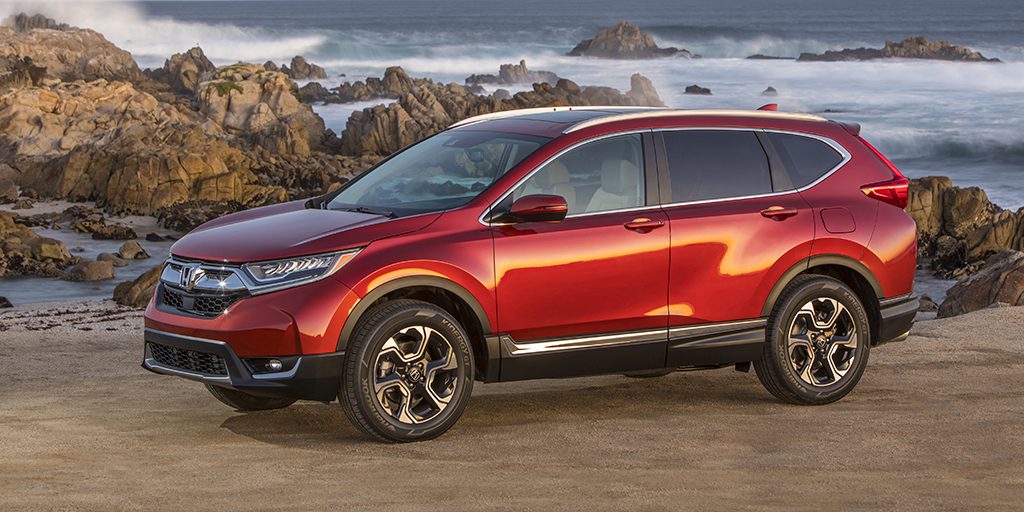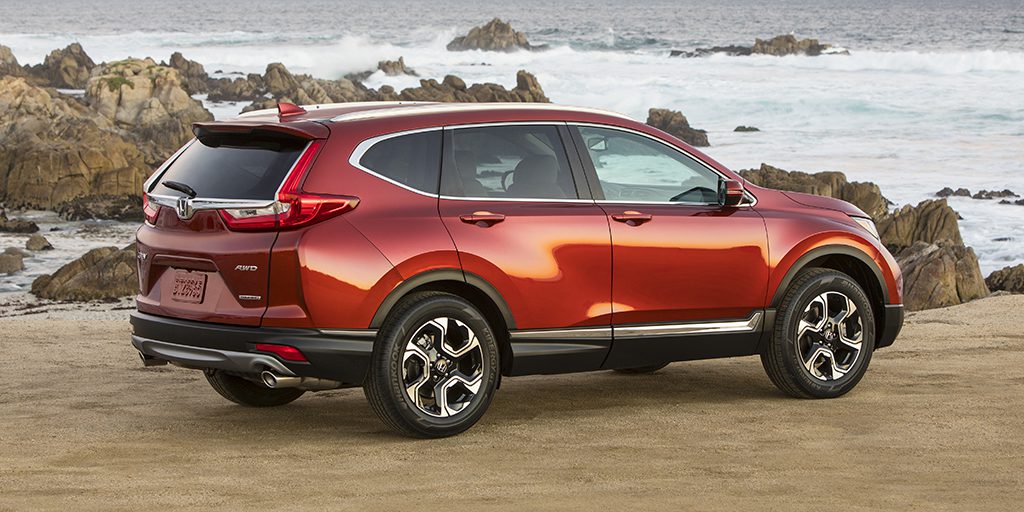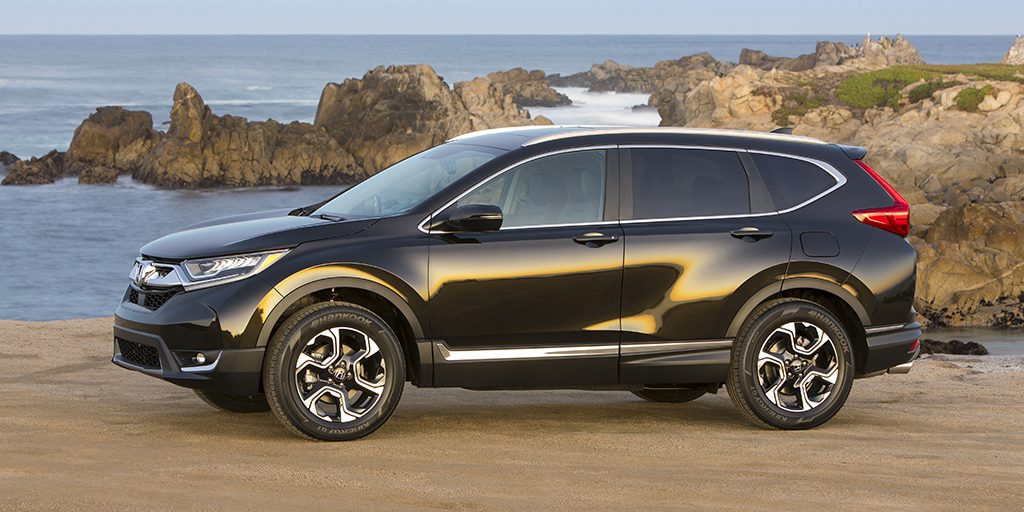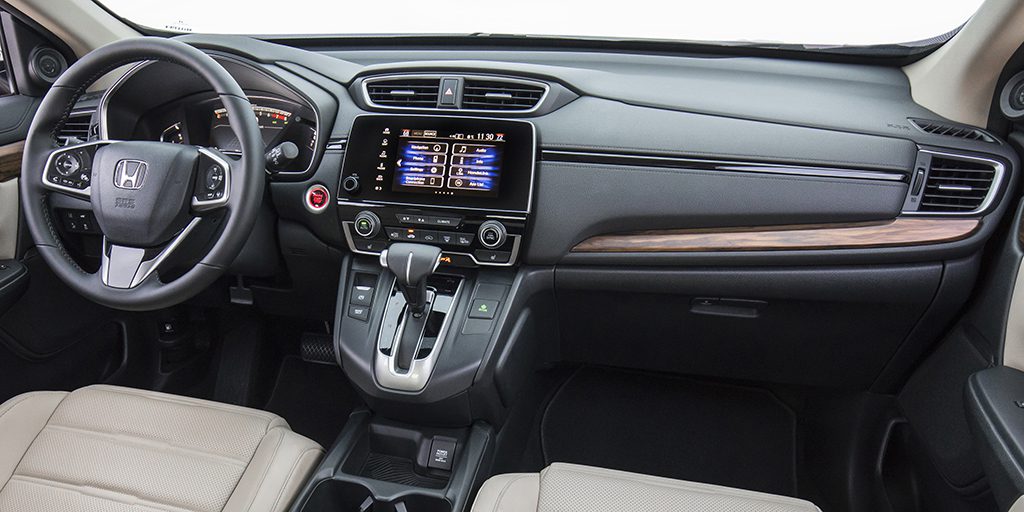Compared to the previous generation, the 2017 Honda CR-V rides a 1.6-inch-longer wheelbase with slightly smaller increases in overall length, width, and height. The combination affords two inches more rear legroom along with notable increases in cargo area, both with the rear seat up (+2 cubic feet) and with it folded (+4.9 cu ft.). The latter results in a total capacity of 75.8 cubic-feet, a figure that puts this compact SUV on par with some 2-row midsize SUVs in terms of cargo space.
Although “dressier” might be a subjective evaluation, there’s much to back it up. The interior is fitted with lots of soft-touch surfaces and is available in two-tone color combinations (black/grey and black/tan), and higher-line models boast rich-looking wood trim.
Trim levels ascend through LX, EX, EX-L, and top-line Touring. While the LX comes fairly well equipped – including such features as a multi-angle (including 180-degree) rearview camera, capless fuel filler, automatic climate control, Bluetooth cell-phone link, Pandora capability, and text-message function – it’s the EX that brings many convenience and safety items most people want. These include heated power mirrors, power moonroof, keyless access and starting, remote engine start, auto on/off headlights, a power liftgate, 7-inch touchscreen, dual-zone automatic climate control, adaptive cruise control, smartphone-based navigation app and assistance system, Apple CarPlay and Android Auto, satellite radio, forward-collision warning and mitigation, lane-departure warning and mitigation, lane-keep assist, and blind-spot monitor. Added with the EX-L are auto-dimming rearview mirror, leather upholstery/steering wheel/shift knob, heated front seats, 8-way power driver seat with 4-way lumbar adjustment, and – optionally – a navigation system with voice recognition and traffic information. The top-line Touring brings the navigation system along with rear cross-traffic alert, rain-sensing windshield wipers, automatic high beams, and hands-free power tailgate.
In the last-generation CR-V, the “knobless” high-end audio interface suffered its share of criticism. (Other Hondas use something similar – with the same results.) So the company made a big deal that an on/off/volume knob had been added to the new generation. That helps, and though it still leaves much to be done through the 7-inch touchscreen, at least it’s fairly easy to reach and use. Climate controls include rotary temperature knobs but a less-convenient repetitive-step push-button for fan speed, and – worse – mode selection has to be done through the touchscreen. Granted, with dual-zone automatic climate control you probably don’t have much call to do manual adjustment, but it’s still nice to have simple knobs when you do.
Then there’s the engine.
One problem with most small, turbocharged engines is that it takes a moment for power to arrive if you have to hurry away from a stop. In most driving, you don’t really notice anything lacking, which makes it all the more surprising when you slam your foot down and not much happens. And that’s the case here. However, full-throttle acceleration is quite linear if not overly strong, and the moaning engine leaves no question that it’s working hard to satisfy. On the plus side, “kickdowns” from the CVT automatic are fairly quick to arrive when the throttle is stabbed at speed, which isn’t always the case with CVTs. But Honda claims the ’17 with the 1.5 turbo is quicker than a ’16 with the 2.4, and then there’s better EPA numbers to consider – so overall, perhaps the new engine can be counted as a plus.
As the CR-V has never really been about “sport,” its chassis tuning tends to favor ride comfort over handling. The CR-V rides quite smoothly. Handling was fine if still not really sporting – which is acceptible for this type of vehicle – and we appreciated the quicker steering ratio used for the new model (you don’t have to rotate the steering wheel as far to make the same turn).
Two more notes in this vein. First, wind and road noise seemed low at highway speeds, and Honda says it has increased ground clearance by about 1.5 inches, leaving front-drive versions at 7.8 inches, AWD versions at 8.2 – the latter, especially, being pretty generous for a compact SUV.
What the CR-V always has been about is space and utility. While really tall folks might wish for a bit more headroom and legroom in front, it’s really tough to criticize the room in back, as 6-footers should fit easily even with the seat ahead pushed all the way rearward. Furthermore, step-in height makes egress a breeze, which is aided further by rear doors that open nearly 90 degrees, far wider than most. Visibility is good except to the rear corners, where it’s only fair, though the standard 180-degree rearview camera really helps when backing.
Cargo space is impressive. It’s wide at the rear and includes side bins, and the floor can be set at two levels: raised, it lies level with the folded rear seat backs and has underfloor storage space, and it can be lowered to take up the underfloor space and make for a taller load area. All but the base LX include a power liftgate, which can be easily adjusted for opening height. Spring for the top-line Touring, and the liftgate can be opened simply by kicking your foot under the bumper.




